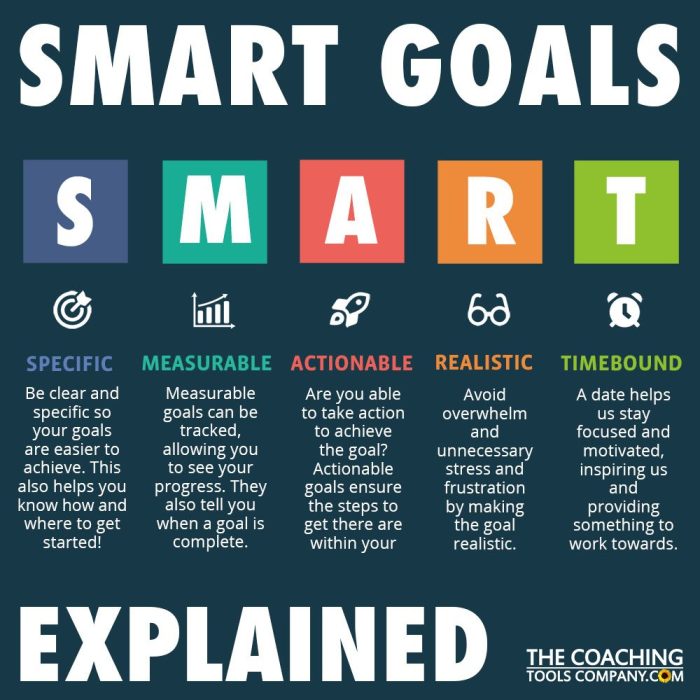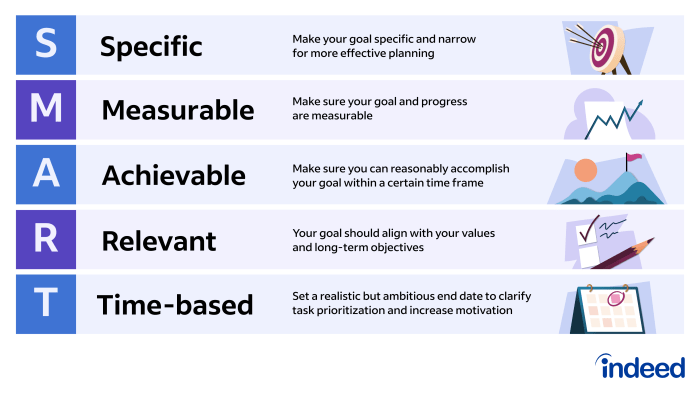Embark on a journey into the realm of goal-setting with “How to Set Goals: 12 SMART Goals for Achieving Success.” Delve into the intricacies of setting goals effectively and witness the transformative power it holds in shaping your path to success.
Explore the key principles and strategies that underpin the concept of SMART goals, paving the way for a purposeful and achievement-driven life.
Introduction to SMART Goals

SMART goals refer to goals that are Specific, Measurable, Achievable, Relevant, and Time-bound. These types of goals provide a clear framework for setting objectives and tracking progress towards success.
Setting SMART goals is essential for achieving success as they help individuals focus their efforts, stay motivated, and measure their progress effectively. By setting goals that are specific, measurable, achievable, relevant, and time-bound, individuals can increase their chances of reaching their desired outcomes.
Examples of SMART Goals
- Health and Fitness: Running 5 miles three times a week for the next three months to improve cardiovascular health and increase endurance.
- Career Development: Completing a certification course in project management within six months to enhance skills and advance in the current job.
- Financial Goals: Saving $500 per month for the next year to build an emergency fund and achieve financial stability.
- Personal Growth: Reading one self-improvement book per month for the next year to enhance knowledge and personal development.
Components of SMART Goals

Setting SMART goals involves breaking down your objectives into Specific, Measurable, Achievable, Relevant, and Time-bound components to increase your chances of success.
Specific
The “S” in SMART stands for Specific, which means your goal should be clear and well-defined. Avoid vague objectives and be precise about what you want to achieve.
- Clearly define what you want to accomplish
- Use specific details and numbers to describe your goal
- Avoid generalizations and ambiguity
Measurable
Goals should be measurable to track progress and determine when you have achieved success. Establish concrete criteria for measuring your progress.
- Set quantifiable indicators to measure success
- Identify milestones to track your progress
- Use metrics to evaluate your performance
Achievable
Goals should be achievable to ensure they are realistic and within reach. Consider your resources, skills, and limitations when setting your objectives.
- Set goals that challenge you but are attainable
- Consider your current commitments and capabilities
- Break down larger goals into smaller, manageable tasks
Relevant
Goals should be relevant to your overall objectives and aligned with your values and long-term plans. Ensure that your goals are meaningful and contribute to your personal or professional growth.
- Align your goals with your values and priorities
- Evaluate the importance of each goal to your overall success
- Ensure that your goals are in line with your long-term vision
Time-bound
Setting a deadline for your goals creates a sense of urgency and helps you stay focused on achieving them in a timely manner. Establish a clear timeframe for completing each goal.
- Set specific deadlines for accomplishing your goals
- Create a timeline with milestones to track your progress
- Avoid procrastination by setting realistic timeframes
Setting and Achieving SMART Goals

Setting and achieving SMART goals is a crucial step towards success in any endeavor. By following a structured approach, individuals can increase their chances of accomplishing their objectives efficiently. Below is a step-by-step guide on how to set SMART goals, strategies for tracking progress, and real-life examples of successful goal achievers.
Step-by-Step Guide on Setting SMART Goals
- Specific: Clearly define the goal you want to achieve. Make it precise and detailed.
- Measurable: Establish criteria to track your progress and determine when the goal is accomplished.
- Achievable: Ensure that the goal is realistic and attainable within your capabilities.
- Relevant: Align the goal with your long-term objectives and ensure it is meaningful to you.
- Time-bound: Set a deadline for achieving the goal to create a sense of urgency and focus.
Strategies for Tracking Progress Towards SMART Goals
- Regular Monitoring: Keep track of your progress consistently to identify any deviations and make necessary adjustments.
- Use Metrics: Utilize specific metrics or key performance indicators to measure your advancement accurately.
- Celebrate Milestones: Acknowledge and celebrate small victories along the way to stay motivated and encouraged.
- Seek Feedback: Solicit feedback from mentors or peers to gain valuable insights and improve your approach.
Real-Life Examples of Successful Goal Achievers
- Elon Musk: The CEO of Tesla and SpaceX, Musk set a SMART goal to revolutionize the electric car industry with Tesla’s mass-market vehicles.
- Oprah Winfrey: Media mogul Oprah Winfrey aimed to create a successful television network (OWN) that aligned with her long-term vision and values.
- Usain Bolt: Sprinter Usain Bolt’s SMART goal was to break world records and become the fastest man on earth through rigorous training and dedication.
Outcome Summary

In conclusion, mastering the art of setting SMART goals can unlock a world of possibilities and propel you towards unparalleled success. With diligence and determination, you can turn your aspirations into tangible realities, one SMART goal at a time.